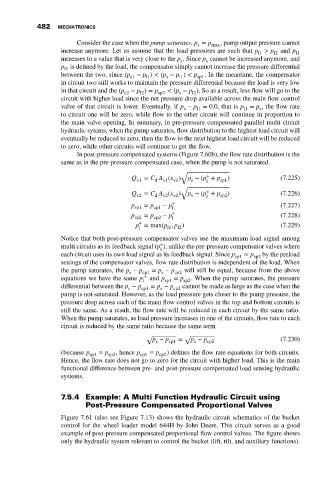Page 496 - Mechatronics with Experiments
P. 496
JWST499-Cetinkunt
JWST499-c07
482 MECHATRONICS Printer: Yet to Come October 9, 2014 8:41 254mm×178mm
Consider the case when the pump saturates, p = p max , pump output pressure cannot
s
increase anymore. Let us assume that the load pressures are such that p > p and p l1
l1
l2
increases to a value that is very close to the p . Since p cannot be increased anymore, and
s
s
p is defined by the load, the compensator simply cannot increase the pressure differential
l1
between the two, since (p − p ) < (p − p ) < p sp1 . In the meantime, the compensator
c1
l1
s
l1
in circuit two still works to maintain the pressure differential because the load is very low
in that circuit and the (p − p ) = p sp2 < (p − p ). So as a result, less flow will go to the
l2
l2
c2
s
circuit with higher load since the net pressure drop available across the main flow control
valve of that circuit is lower. Eventually, if p − p = 0.0, that is p = p , the flow rate
l1
s
s
l1
to circuit one will be zero, while flow to the other circuit will continue in proportion to
the main valve opening. In summary, in pre-pressure compensated parallel multi circuit
hydraulic sytems, when the pump saturates, flow distribution to the highest load circuit will
eventually be reduced to zero, then the flow to the next highest load circuit will be reduced
to zero, while other circuits will continue to get the flow.
In post-pressure compensated systems (Figure 7.60b), the flow rate distribution is the
same as in the pre-pressure compensated case, when the pump is not saturated.
√
∗
Q v1 = C A (x ) p − (p + p sp1 ) (7.225)
d
v1
v1
s
l
√
∗
Q v2 = C A (x ) p − (p + p sp2 ) (7.226)
d
v2
v2
s
l
p sp1 = p cp1 − p ∗ l (7.227)
p sp2 = p cp2 − p ∗ l (7.228)
∗
p =max(p , p ) (7.229)
l2
l1
l
Notice that both post-pressure compensator valves use the maximum load signal among
∗
multi circuits as its feedback signal (p ), unlike the pre-pressure compensator valves where
l
each circuit uses its own load signal as its feedback signal. Since p sp1 = p sp2 by the preload
settings of the compensator valves, flow rate distribution is independent of the load. When
the pump saturates, the p − p cp1 = p − p cp2 will still be equal, because from the above
s
s
equations we have the same p ∗ and p = p . When the pump saturates, the pressure
l sp1 sp2
differential between the p − p = p − p cannot be made as large as the case when the
s cp1 s cp2
pump is not saturated. However, as the load pressure gets closer to the pump pressure, the
pressure drop across each of the main flow control valves in the top and bottom circuits is
still the same. As a result, the flow rate will be reduced in each circuit by the same ratio.
When the pump saturates, as load pressure increases in one of the circuits, flow rate to each
circuit is reduced by the same ratio because the same term
√ √
p − p cp1 = p − p cp2 (7.230)
s
s
(because p sp1 = p sp2 , hence p cp1 = p cp2 ) defines the flow rate equations for both circuits.
Hence, the flow rate does not go to zero for the circuit with higher load. This is the main
functional difference between pre- and post-pressure compensated load sensing hydraulic
systems.
7.5.4 Example: A Multi Function Hydraulic Circuit using
Post-Pressure Compensated Proportional Valves
Figure 7.61 (also see Figure 7.13) shows the hydraulic circuit schematics of the bucket
control for the wheel loader model 644H by John Deere. This circuit serves as a good
example of post-pressure compensated proportional flow control valves. The figure shows
only the hydraulic system relevant to control the bucket (lift, tilt, and auxiliary functions).

